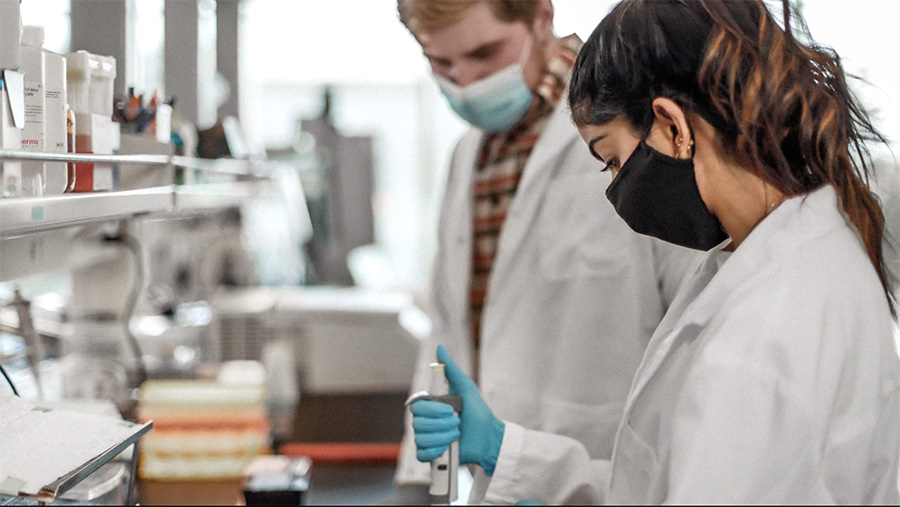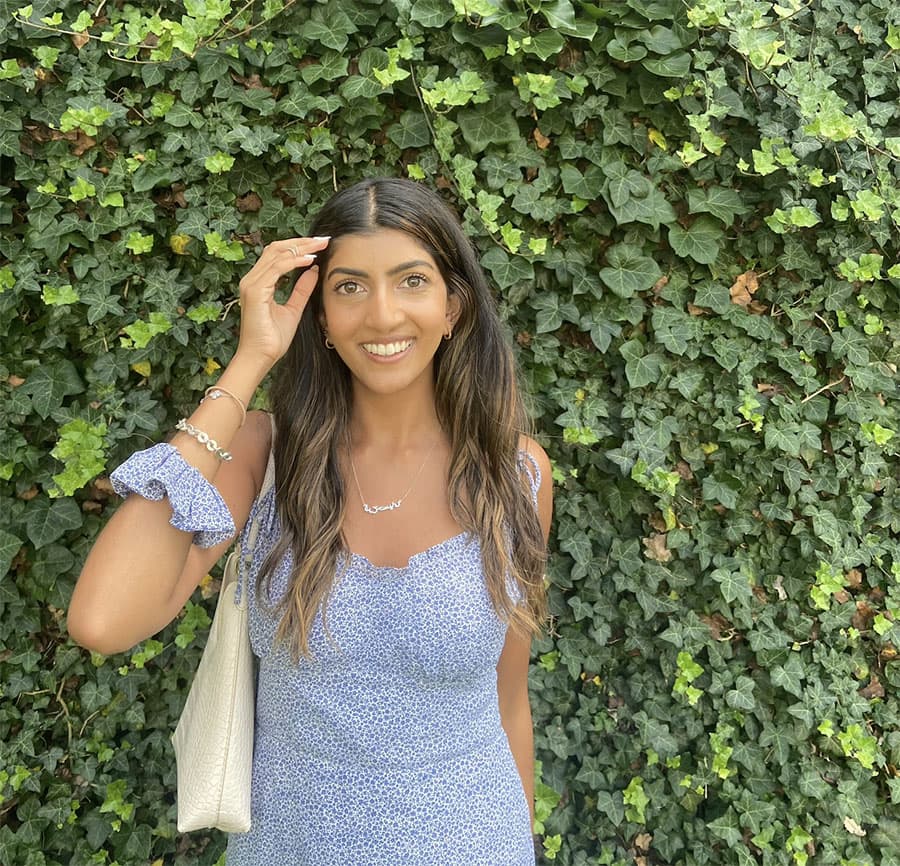Biology Major Farah Hussaini Shares Tips for Getting Involved in STEM at AU

Right from the start, Farah Hussaini (BS biology ’23), has taken advantage of everything STEM at American University. As such, we couldn’t think of anyone better to give tips and recommendations to incoming students who are interested in getting involved in STEM. Read on to learn more about Farah, her STEM experiences at AU, and how you can get involved.
Immersed in STEM
During her time at AU, Farah has balanced her biology major, pre-med credits, a public health minor, an applied physics minor, and study abroad in London in the Health and Society program at King’s College London, which accepts only 16 students in the world.
Farah also conducted two years of cancer research in Professor Katie DeCicco-Skinner’s laboratory and received a prestigious NASA DC Space Grant Consortium AU STEM Research Fellowship, as well as AU’s Gloria Likins Endowed Scholarship. She was a peer tutor in the AU Biology lab and served as student editor for Catalyst, AU's student science magazine. Farah is a member of the pre-med fraternity on campus, Phi Delta Epsilon, and she has been on the Dean’s List for consecutive semesters.
Farah, you hit the ground running as soon as you arrived on campus. Can you share some of the activities and resources that helped you acclimate during your first year?
I tried to focus mostly on classes during my first semester at AU and adjust to the college curriculum before diving into extracurricular activities. I was taking a full course load as a freshman, including a 300-level cell biology class, general chemistry, and intensive college writing.
One of the resources that helped me immensely was academic coaching at AU. I’ve worked with coach Stacey Miles since my very first semester at AU. She’s helped me with time management and given me different strategies, planners, and templates. I know the academic coaches help students with several different areas, such as study skills, procrastination, and organization, but time management was always most challenging for me because I had such a packed schedule. It was one of those things where I didn’t really think I needed it until I booked an appointment and realized it was something that I can’t live without!
I also met with the biology department chair, Dr. DeCicco-Skinner, during my first couple of weeks at AU to introduce myself and ask some questions about the biology major. I remember asking her about what the biology major program is like, how rigorous it is, if students can study abroad, what kinds of research opportunities there are, etc. Little did I know that she would end up being one of my greatest mentors in college. I ended up working in her lab and being the supplemental instructor for two years. Forming connections with professors is really important because they all have helpful advice and guidance to offer. It was also great having a mentor, especially a female mentor, while pursuing a male-dominated field like the sciences.

You’ve done a remarkable amount of cancer research in Professor DeCicco-Skinner’s lab. Can you describe the work?
My interest in cancer research began in Dr. DeCicco-Skinner's cell biology class when we learned about signal transduction pathways. I found it so interesting how one receptor interaction was able to produce a massive cascade of events afterwards, and how each pathway was connected in such intricate ways. After completing the class, Dr. DeCicco-Skinner invited me to work in her cancer lab. I began working in her lab in my second semester of freshman year. I was exposed to so many different techniques and gradually built my confidence to perform some techniques independently.
There were two main projects going on in the DeCicco lab – the skin project and the multiple myeloma project.
The skin project examined tumor progression locus 2 (Tpl2) gene and its role as a novel tumor suppressor in cutaneous squamous cell carcinoma (cSCC). Cutaneous squamous cell carcinoma (cSCC) is a non-melanoma form of skin cancer characterized by the uncontrollable growth of abnormal squamous cells. Tumor progression locus 2 (Tpl2) is a tumor suppressor gene that regulates a pathway called MAPK – a key pathway in controlling cell proliferation. Mutations or the absence of Tpl2 entirely can be detrimental and cause cSCC to progress rapidly. cSCC treatment is often met with therapeutic resistance, which is likely due to crosstalk between different receptors relevant to the MAPK pathway. In other words, the drugs that inhibit these pathways are often deemed ineffective as they have numerous escape mechanisms and alternative pathways. The inhibition of one pathway ultimately leads to the activation of another. As a result, the targeted effects of the drug still allow the cancer to reach its end goal: accelerated and uncontrollable cell growth. The skin project in the DeCicco lab explored these different pathways by using receptor inhibiting drugs to prevent cSCC progression.
Multiple myeloma is a type of blood cancer that forms in plasma cells. Uncontrolled growth of plasma cells impacts the formation of antibodies, which hinders the immune response. The mechanisms of multiple myeloma are largely unknown in the scientific community, making it difficult to develop drugs for the illness. The multiple myeloma project in the DeCicco lab examined the relationship between antibiotic resistance and obesity on the growth and proliferation of multiple myeloma cells. More specifically, we examined if lean versus obese human adipocytes (fat cells) have different effects on the growth of multiple myeloma cells. By understanding these relationships and mechanisms, we were able to contribute to the growing body of research about multiple myeloma.
I was exposed to many laboratory techniques in these projects, such as western blotting, qPCR, and cell culture.
Academically, you have squeezed in quite a lot during your time at American University! Can you share some of your other activities during your time here?
I served as the philanthropy chair for my sorority, Delta Gamma, this past year. Our work serves the non-profit Service for Sight, which works to improve the lives of blind and visually impaired communities. This encompasses a wide range of efforts, such as establishing schools for the blind, training assistance dogs, funding eyeglasses for low-income families, and volunteering with communities that are at high-risk of visual impairments such as the elderly and veterans.
During my time as philanthropy chair, I organized an AU-wide webinar with a guest speaker from the Prevention of Blindness Society, organized several letter-writing events where members could write letters to veterans and the elderly, raised more than $4,000 to benefit our philanthropy, and established corporate sponsorships with companies including SoulCycle, Orange Theory Fitness, Equinox, the Kennedy Center, and more. Currently, I am working on our annual fundraiser taking place in September, Anchor Splash, with hopes to raise $8,000 for Service for Sight.
Also, I love spin classes and Pilates. I actually work at SoulCycle! I think it’s important to have a balance and schedule activities outside of academics.

Can you tell us how you get so many things done, and how you find balance?
One of my favorite things about my schedule is its well-roundedness, balance, and diversity. I have a strong interest in the sciences, and I’ve tried to apply that in different contexts.
I worked in a lab setting doing cancer research for two years which taught me so much about collaboration, critical thinking, and problem solving. I had the opportunity to apply the scientific concepts that I learned in class and really make them come to life. And of course, it’s an honor to contribute to the global efforts to understand the mechanisms of cancer.
As editor of Catalyst, I was able to apply my interest in the sciences in a different light. I had the opportunity to hone my scientific writing skills and learn about a range of topics, from microplastic research to the urban heat island effect.
I gained strong leadership, active listening, and communication skills as a supplemental instructor. It was also the ultimate test of my scientific knowledge because I had to make really complex ideas easy to understand for people, many of whom had different learning styles and foundations in the sciences.
Being a health and safety ambassador as well as the philanthropy chair for my sorority allowed me to apply my love for the sciences to real-world scenarios. These experiences tackled bigger questions for me - how do I raise awareness about common visual impairments and disease prevention among the public? How can I contribute to ending the pandemic? How can I take the skills I learned inside of the classroom, and apply those to situations outside of the academic walls?
All in all, I curated my schedule so I could teach, lead, write, and research. Each activity yielded a new skill set. My love for the sciences tied everything together.
How is being involved in so many activities helping you reach your goals?
My ultimate goal is to become a physician. Each activity I’ve participated in has given me a unique skillset that I’m sure will benefit me in the future. Cancer research taught me collaboration and critical thinking, being a supplemental instructor honed my communication and leadership skills, and working for Catalyst refined my scientific writing skills in several different disciplines. I could see all these skills coming into play in my future career.
Finally, from your experience, what are the top three ways for an incoming student to get involved in STEM at AU?
Research
There are so many different labs on campus that conduct fascinating research. If you check the AU website, you can find some written bios of each professor and their research interests. Take a look and find something you’re interested in or curious about – for me, it was cancer and signal transduction. Reach out to professors and let them know that their research sparked your interest. Having a research position was a great way for me to get involved as a freshman because it introduced me to upperclassmen STEM students. They offered me great advice about everything from different STEM-related clubs at AU, the classes they enjoyed the most, to their strategies for MCAT preparation.
Accessible professors
One of the biggest advantages of AU’s STEM program is that it’s on the smaller side, so you can really get to know the faculty. Just looking at my experience – I was able to get to know Dr. DeCicco-Skinner during my first semester of college when she was my cell biology professor. I went to office hours almost every week and practically bombarded her with questions about the course material. In the process, I got to know her and eventually started researching in her lab, then being a supplemental instructor for her class. Introduce yourself to your professors in classes, go to office hours, and take all their guidance to heart. At the end of the day, they truly want you to succeed.
Clubs
There are so many different STEM related clubs at AU to get involved in. If you want to try scientific writing, try writing for Catalyst. If you’re interested in health advocacy and community service, get involved with Days for Girls AU or One Tent Health. If you want to learn more about environmental science, try the Sustainable Ocean Alliance or the Zero Waste Club. By applying your STEM interests outside of the classroom, you’ll gain valuable skills and make some great friends along the way.
Check out our resources for STEM students, including clubs, community service opportunities, and scholarships and fellowships.
